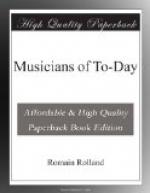These compositions alone place him in the front rank of contemporary musicians. They abound in faults; but their qualities are so rare, and his soul shines so clearly through them, and such fine sincerity breathes in them, that I have not the courage to dwell on their weaknesses. So I shall content myself with remarking, in passing, that the orchestration is inadequate and awkward, and that the young musician should strive to make it fuller and more delicate; and though he shows great ease in composition, he is often too impetuous, and should resist this tendency; and that, lastly, there are sometimes traces of bad taste in the music and reminiscences of the classics—all of which are the sins of youth, which age will certainly cure.
Each of the oratorios is really a descriptive mass, which from beginning to end traces out one dominating thought. Don Perosi said to me: “The mistake of artists to-day is that they attach themselves too much to details and neglect the whole. They begin by carving ornaments, and forget that the most important thing is the unity of their work, its plan and general outline. The outline must first of all be beautiful.”
In his own musical architecture one finds well-marked airs, numerous recitatives, Gregorian or Palestrinian choruses, chorales with developments and variations in the old style, and intervening symphonies of some importance.
The whole work is to be preceded by a grand prelude, very carefully worked out, to which Don Perosi attaches particular worth. He wishes, he says, that his building shall have a beautiful door elaborately carved after the fashion of the artists of the Renaissance and Gothic times. And so he means to compose the prelude after the rest of the oratorio is finished, when he is able to think about it in undisturbed peace. He wishes to concentrate a moral atmosphere in it, the very essence of the soul and passions of his sacred drama. He also confided to me that of all he has yet composed there is nothing he likes better than the introductions to The Transfiguration and The Resurrection of Christ.
The dramatic tendency of these oratorios is very marked, and it is chiefly on that account that they have conquered Italy. In spite of some passages which have strayed a little in the direction of opera, or even melodrama, the music shows great depth of feeling. The figures of the women especially are drawn with delicacy; and in the second part of Lazarus, Mary’s air, “Lord, if Thou hadst been here, my brother had not died,” recalls something of Gluck’s Orfeo in its heart-broken sadness. And again, in the same oratorio, when Jesus gives the order to raise the stone from the tomb, Martha’s speech, “Domine, jam foetet,” is very expressive of her sadness, fear, and shame, and human horror. I should like to quote one more passage, the most moving of all, which is found in the Resurrection of Christ, when Mary Magdalene is beside the tomb of Christ; here, in her speech with the angels, in her touching lamentation, and in the words of the Evangelist, “And when she had thus said, she turned herself back, and saw Jesus standing, and knew not that it was Jesus,” we hear a melody filled with tenderness, and seem to see Christ’s eyes shining as they rest on Mary before she has recognised Him.




